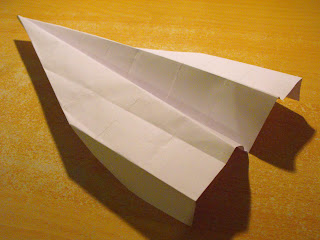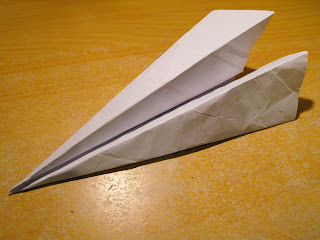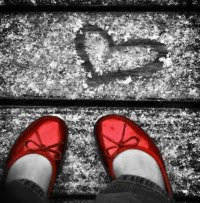Monday, June 14, 2010
change of plans
D=....I'm writing the discussion now....and it's killing me, but I must admit, the introduction was much more time consuming since there was basically no relevant info on the internet about how the shape of the wings affect a paper plane's flight -.-.
Ah well~
Sunday, June 13, 2010
Pictures of the experiment!~
 that turned to this:
that turned to this: Oh, and Ms Zhang, what do we have to include in our blog for the final submission?
Oh, and Ms Zhang, what do we have to include in our blog for the final submission?Sunday, June 6, 2010
Results

In the real report, I won't put the observations, because I don't think they are relevant to my topic, but they are here on my blog if you guys are interested ^^.
CYAZ~
Sunday, May 30, 2010
Other controlled variables...
Also, I have decided to glue the centres of my planes together so that wind does not leak through the centre cavity and affect the flight of the planes....do you get me? But I have controlled this because I'm doing it to every plane, and placing the same amount of glue on each. I was about to use paper clips or staples, but figured they may be too heavy.
Awesome~~ I shall go and try it again -.-.
Doing experiment today peeps
Awesome. Great day to do my airplane experiment (just hope it doesn't rain in the middle of it), so I'm going now!! Stay tuned to find out what you want to find out =D.
Tuesday, May 11, 2010
Aha...how am I going to do my experiment?
Equipment:
- A 30cm piece of ribbon
- 7 pieces of paper
- A 15 metre tape measure.
- 2 medium-sized rocks
Method:
- Fold all 7 of the plane designs.
- Set up equipment as follows:
- Stand at the ribbon so that the tip of your front foot is just behind the ribbon.
- Throw The Simple Plane into the air with its nose pointing directly to the direction it will be thrown.
- Measure the perpendicular distance flown by the plane from the ribbon.
- Record the results in a table.
- Repeat steps 3 to 6 with The Bird, The Arrow, The Arrow Folds Up, The Arrow Folds Down, The Dart and The Moth.
- Repeat steps 3 to 7 two more times.
- Discuss and analyse the data collected.

Yes that is my method.....hope that's okay....
Monday, May 10, 2010
My Plane Designs ^^
Here they are:


This design is known as The Arrow....yeah awesome name isn't it? It's also a very simple design that I will build on.
 This model is quite the same as the image above, but instead of folding the wings UP this time, I folded them DOWN. I'll call this The Arrow Folds Down (creative ain't it?). See how that affects the distance it flies =D.
This model is quite the same as the image above, but instead of folding the wings UP this time, I folded them DOWN. I'll call this The Arrow Folds Down (creative ain't it?). See how that affects the distance it flies =D. Muahahaha, this is called The Dart. Yes...reminds me of a ninja...hope it's just as fast and that it travels far. The Dart is a bit shorter than The Arrow, so from this, I will be able to see how the shortness of a plane affects its flight. The shortness is also part of the shape of the wing, so I have to investigate that too.
Muahahaha, this is called The Dart. Yes...reminds me of a ninja...hope it's just as fast and that it travels far. The Dart is a bit shorter than The Arrow, so from this, I will be able to see how the shortness of a plane affects its flight. The shortness is also part of the shape of the wing, so I have to investigate that too. My dear friends, I would like to sadly announce that this is unfortunately my last model that I will be testing out in my experiment (sorry for 1. the enormous amount of creases on the paper and 2.the very unnaturally formal language used in the above sentence). Anyways, this design is known as The Moth...the names just keep on getting more interesting as we go don't they? This is the model with 'the blunt nose' so I'll be testing that out too, like if a paper plane needs 'a pointy nose' to be able to fly steadily and far.
My dear friends, I would like to sadly announce that this is unfortunately my last model that I will be testing out in my experiment (sorry for 1. the enormous amount of creases on the paper and 2.the very unnaturally formal language used in the above sentence). Anyways, this design is known as The Moth...the names just keep on getting more interesting as we go don't they? This is the model with 'the blunt nose' so I'll be testing that out too, like if a paper plane needs 'a pointy nose' to be able to fly steadily and far.Now you guys have probably noticed that I have used models that are quite similar in shape. This is because although I am testing whether the shape of the wings of planes affect the distance it flies, I want to be able to control the amount of change I make to each model, because it's only then that I can obtain the most accurate results and conclusions to answer my aim. I try to change one variable at a time with my different models.

I did not use this model as it is too different from the other ones, and I would not be able to reach accurate conclusions if I compared this with the other models as I would've had to change too many variables.
NOTE: real models will not contain creases, as I know these can affect the flight of the plane.
Sunday, May 9, 2010
Tuesday, May 4, 2010
Who loves chocolate???
Anyways, who wants to buy my lovely scrumptious-looking-and-tasting chocolate???!!! Of course you all do, including you Ms Zhang right?
Just saying...
BUY MY CHOCOLATE PEOPLES OR ELSE........................you won't get any chocolate.
Hehe, just thought I'd say that.....for those who don't like chocolate, HAPPY EXPERIMENTING =D!!~ good luck guys YEAH!!~
Friday, April 9, 2010
Mmm.....research...
AND THIS IS WHAT I FOUND::
forces affecting plane flight:
- engine makes the plane go forward, by providing THRUST.
- But as the plane is being pushed forward, it is also being held back by air resistance, and this is known as DRAG.
- the force of gravity on the plane is known as its WEIGHT.
- counteracting this force is the LIFT, which pushes the plane up.
Now for the plane to fly forward and for it to actually fly, the thrust force has to be greater than the drag force (this can be easily obtained in my experiment, because my paper planes will have a smooth aerodynamic shape, and the force in which i throw it out will be greater than air resistance, although, air resistance will slow it down a little) , and the lift force has to be greater than the force of gravity on the plane.
Source: www.worsleyschool.net/science/files/flight/page.html
So I've decided to use maybe 4-6 different planes with differently shaped wings and repeat my experiment at least 3 times, but I'll see if I get similar results in the first 3 tries first, and if the results clearly show which wing shape is the best, then I might not do the experiment another time, but I guess at this stage, I'll just go with the flow.
Since I'm using the same sized paper for each plane so that it is a fair test, I'm only going to fold the wings differently, and not do any cutting or anything.
I haven't decided yet on the shapes I'm going to use, but this wing shape is definitely going to be included as it is the most popular (it is said that this wing shape flies the furthest, but I'll have to prove that for you guys ^^) and is one of the most basic shapes to fold:
Friday, April 2, 2010
YAY APPROVED

Tuesday, March 30, 2010
ugh...
Monday, March 8, 2010
hehe aeroplanes ^^
How does the shape of the wings of paper aeroplanes affect the distance they are able to travel?
Independent variable is the shape of the wings.
Dependent variable is how far it travels.
Controlled variables:
- fly all aeroplanes one after the other and at the same location, so the change of weather does not affect the results.
- one person throws all aeroplanes.
- to throw all aeroplanes with your dominant hand.
- don't have obstacles in its path that can affect the distance it travels.
- use the same measuring device to measure.
- for every plane, measure from the exact same distance
- use the same planes for repetition of experiment.
- use same thickness paper to make each plane.
- use blank pieces of paper of the same size.
Interesting....
And the other idea =D
This is the experiment investigating bonds formed between water molecules, and the basics to how an umbrella works ^.~.
The independent variable is the number of pin holes I poke into the paper.
The dependent variable is whether the water will leak through the holes or not.
Controlled variables:
- same cup used for repetition of experiment
- paper has to be pressed firmly down along the edge of the cup, so it creases along the edge of the cup.
- paper has to be flat.
- use the same pin every time for poking the holes
- use paper of the same thickness
- don't squeeze water out of cup, so hold it in the same way for each repetition of the experiment
I don't know which experiment to choose...
Mmmm....don't know if this is valid
How much water do you have to put into a cup to make sure that when it is inverted with a piece of paper covering the opening, the water doesn't fall out at all, even when your hand is removed?
Independent variable in this experiment: how much water you put into the cup.
Dependent variable: (without hand support) if the paper will fall off or not.
Controlled variables:
- Use same measuring cup for measuring amount of water, each time you measure
- Use the same cup for the water for repetition of experiment
- Use a flat piece of paper
- Make sure the paper is pressed firmly around the edges of cup so that it makes a fold on the paper around the edge of the cup
- make sure paper is not ripped
- use paper of the same thickness
Sunday, March 7, 2010
Yeah!~
I'm looking forward to actually doing the experiment, and it won't take long, because it's simple and quick, but can prove a lot of things!~
Sounds fun!~ and good luck everyone on getting your ideas~
finally have an experiment idea...
If you fill the cup with water, poke holes in a piece of paper, and then use it to cover the cup, and then flip the cup upside down holding the piece of paper over the cup, and then slowly take your hand away...will the paper fall off? Will the water leak through the holes? What do you guys think? I'll find out for you all through this experiment ^^.
I've always found this interesting, how umbrellas can prevent us from getting wet, I mean, if you squint and look closely at the cloth of the umbrella, there are visible holes. So why doesn't the rain just fall through those holes, I mean, liquid can leak through any hole, no matter what the size, right? This will also be investigated through this experiment ----- the bonds formed between water molecules~.
If I were to conduct this experiment, the dependent variable will be whether the paper will fall off or not, and whether water will leak through or not.
The independent variable in this experiment is the amount of air entering into the upside down cup.
The variables that will need to be controlled include the following:
- the paper cannot be folded, it has to be flat
- the size of the paper has to fully cover the opening of the cup
- the same size of paper should be used for repeating the experiment
- the paper has to be pressed down firmly around the edges of the cup
- the holes should only be poked with a pin, nothing bigger
- the same pin should be used when repeating the experiment
- the same cup should be used when repeating the experiment
- the same amount of water has to be used for repeating the experiment
That's all I can think of so far....can't come up with anything else, and I'm kind of confused about the dependent and the independent variable in this experiment....hard D=.
Hope this works ^^!
Friday, March 5, 2010
SRP initial idea o.O
That is why I will think, think, and think more... until I come up with something fun ^^. Gosh, THINK MARY THINK!!!








